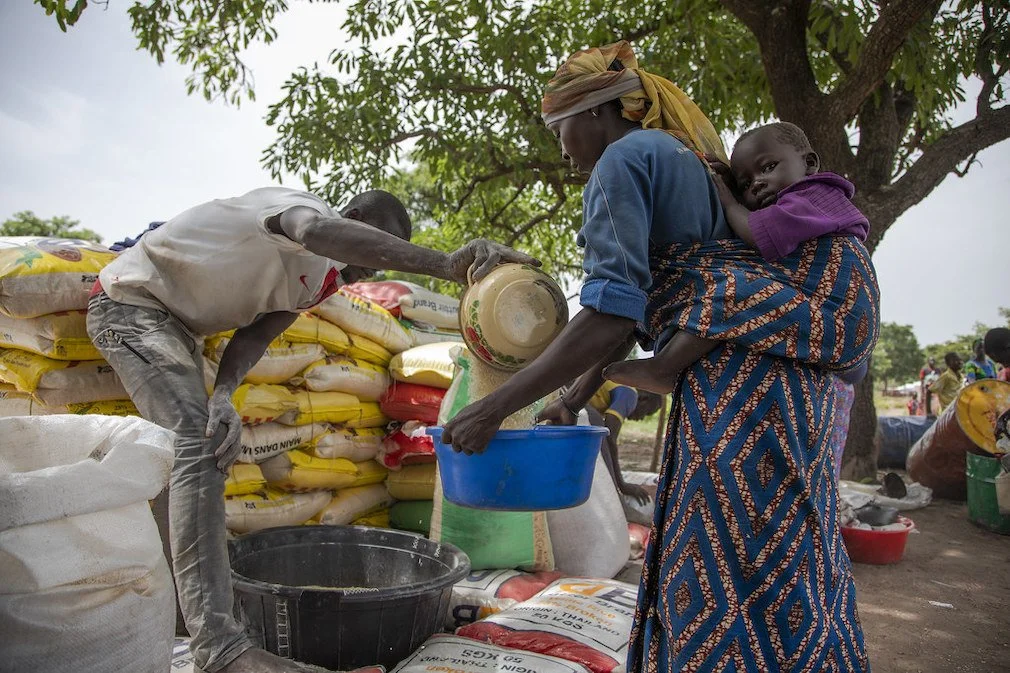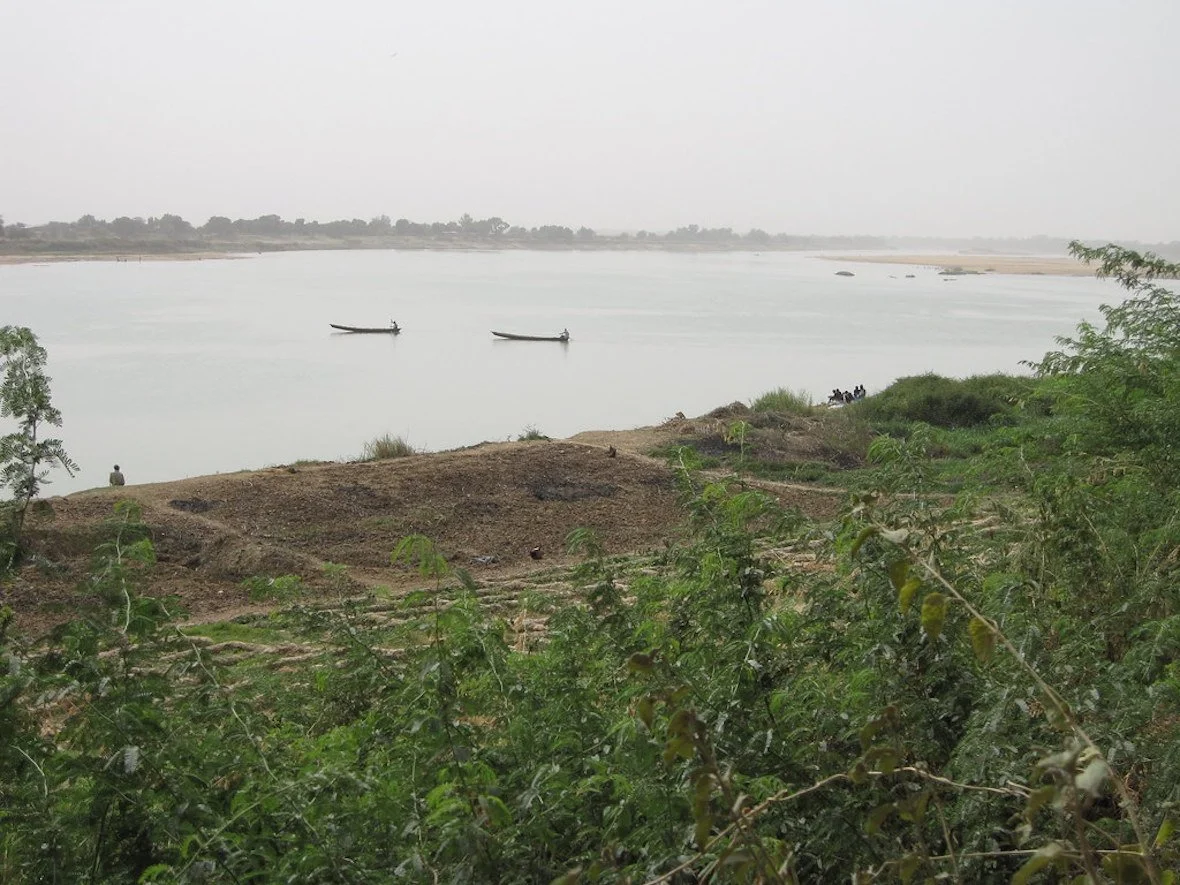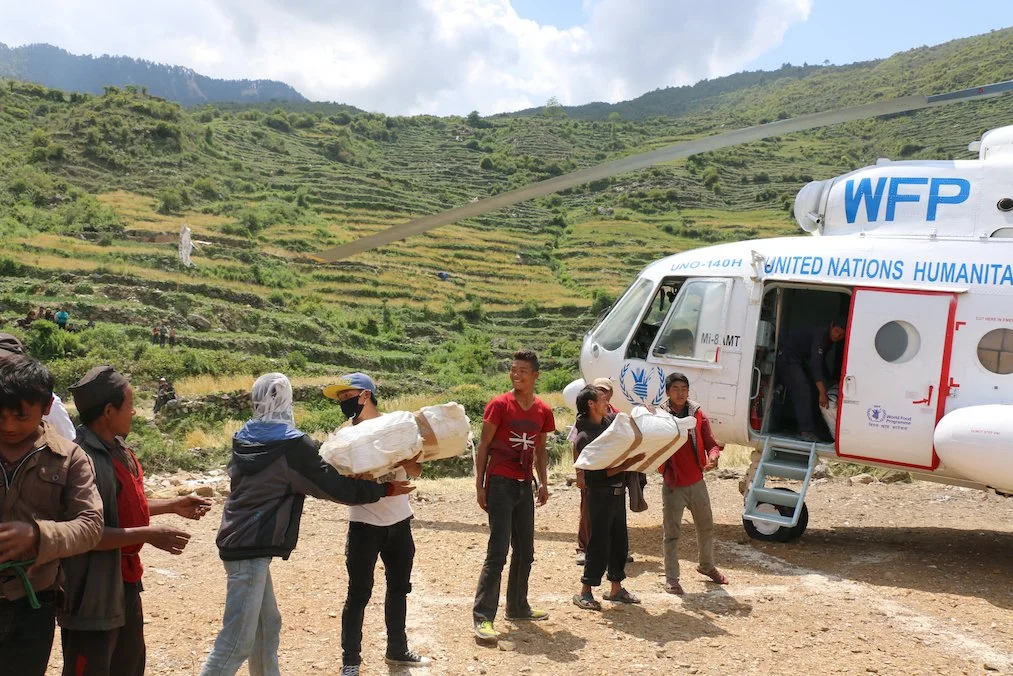Chad’s Zakouma National Park has transformed from a hotspot for poaching into a sanctuary for wildlife.
Read MoreChad is the Country Most Vulnerable to Climate Change
In Chad, climate change creates new challenges for an already disadvantaged population.
Humanitarian aid in Chad. EU Civil Protection and Humanitarian Aid. CC BY-NC-ND 2.0.
Due to its geography, Chad has experienced a temperature increase of 1.5 times higher than other places in the world. With additional disadvantages of poverty and political conflict, Chad has been ranked as the country most vulnerable to climate change. Here are some of the ways Chad is currently being affected by climate change, as well as current action against this crisis and ways you can help.
Lake Chad
Satellite images of Lake Chad’s shrinking waters between 1984 and 2018. Fae. CC BY-SA 3.0 IGO.
With a surface area of 2.3 million square kilometers, Lake Chad is the country’s reservoir. Climate degradation has taken a toll on this freshwater inland sea over the decades, resulting in its shrinkage of 90 percent within the past 60 years. Not only does this affect the country of Chad itself, but also surrounding nations that rely on Lake Chad, such as Nigeria, Niger, and Cameroon. The increasing lack of this water source reduces the availability of drinking water for both humans and animals, and also impacts irrigation and fishing. Access to clean water is an existing issue in Chad, with only 43 percent of the population able to obtain clean drinking water, forcing many to consume unsafe water that exposes them to diseases like cholera.
Flooding
Chari River. Afcone. CC BY-ND 2.0.
In sharp contrast to the drought affecting Lake Chad, the rest of this Sahelian Republic has suffered flood damage over the past year, caused by its heaviest rain season in 30 years. In October of 2022, both the Chari and Logone rivers overflowed, causing 18 out of 23 Chadian provinces to flood. This flooding has affected more than 340,000 people, destroying thousands of homes and farmland. Though climate change has caused much drought in Chad, it is also a contributing factor to this flooding. As climate change causes temperatures to rise, it allows for more evaporation from the ground and water sources, leading to extended periods of drought and punctuated by bursts of extreme rainfall.
Illness
Medicine in Faya-Largeau, Chad. Gerhard Holub. CC BY-SA 4.0.
Another way climate change endangers Chadians is by increasing the probability of illness transmission. As mosquitoes are attracted to water, increased flooding could create a greater risk of malaria contraction. In 2022, there were 1.8 million cases of malaria in Chad, with over 2,500 fatalities. Though malaria cases have decreased over the last 20 years due to an increase in treatment and preventative measures, they have been rising within the last decade, with 190 cases per 1,000 at risk in 2014 versus 206 cases per 1,000 in 2021. An uptick in temperatures can also cause a greater risk of meningitis, an illness that is common in Southern Chad, which is part of a region known as the “Meningitis Belt.” Heatstroke is also a danger to Chadian people, as well as malnutrition, as crops are destroyed by drought and flooding. With only 1 in 17 children having access to soap and water to wash their hands with, there is already a public health crisis in Chad, and rising temperatures only exacerbate the problem.
Resolutions
World Food Programme. Anjeli Mendoza. CC BY-SA 4.0.
Chad National Adaptation Plan Advancement Project (NAP)
Launched in 2018, the NAP was created as part of Chad’s national contribution to the Paris Climate Agreement. With this plan, eight areas are prioritized, including environmental subjects such as agriculture, forests, sanitation, water resources, and more. National planning and budgeting are being developed on these fronts, all aiming to improve conditions for the Chadian population.
United Nations (UN)
In April, the United Nations appealed for $674 million for a humanitarian response plan, in order to address climate, health, and food crises in Chad. The Sustainable Development Group of the UN also aims to aid the country in its struggles by helping the government enact national security, humanitarian and economic policies.
World Food Programme (WFP)
The WFP provides nutritional support to infants, young children, and pregnant women in order to combat malnutrition in Chad, helping 458,000 children and 235,400 nursing and pregnant women in 2021. WFP has also provided meals to schoolchildren and helped restore degraded land.
To Get Involved
Click here to donate to the World Food Programme.
Click here to donate to the International Committee of the Red Cross.
Click here to donate to UNICEF.
Alexandra Copeland
Alexandra Copeland is a student at The College of New Jersey studying psychology and journalism. She is a lover of coffee, dancing, and visiting new places. Being raised with her Greek culture has inspired her interest in cultural customs around the world. She is a passionate writer and hopes that her work will make an impact in the future.
The World's 10 Hungriest Countries
There are over 870 million people in the world who are hungry right now. I'm not talking about could use a snack before lunch hungry, not even didn’t have time for breakfast hungry, but truly, continually, hungry.
Of these 870 million people, it's been estimated by the World Food Programme that 98% live in developing countries, countries that perversely produce most of the world’s food stocks. So why is this the case?
Here we look at the top 10 worst affected countries and see what obstacles are making them hungry and why:
1. Burundi
Image: Imgur
73.4% of the population is believed to be undernourished.
Sitting between Rwanda, the Democratic Republic of the Congo and Tanzania, Burundi is a landlocked country, which means that on average it will experience 6% less economic growth than non landlocked countries, mainly due to the cost of transport for import and export transactions.
Over half of Burundi’s 9.85 million citizens live below the poverty line, with an estimated 35% of the population being out of work.
The main problem with Burundi is not that it can’t produce food, but that due to overpopulation, soil erosion, climate change, high food prices and an ongoing civil war, the country has to import more than they are exporting. In the last few years alone due to these factors, and the increase of internally displaced citizens who can’t produce their own food, the subsistence economy of Burundi has contracted by 25%.
Looking at the current economic and political climate of Burundi it is clear to see that poverty alone isn’t the cause of hunger, but that many external factors contribute to the hardship being endured.
2. Eritrea
Image: Imgur
65.4% of population have been classified as undernourished.
Eritrea, which is located in the Horn of Africa, has experienced considerable growth to its economy in recent years, but unfortunately the effect of this hasn’t trickled down to its citizens or the food chain.
In 2004, agriculture employed nearly 80 percent of the population but accounted for only 12.4 percent of gross domestic product (GDP). The agricultural sector has improved with the use of modern farming equipment and techniques; however, it is still compromised by a lack of financial services and investment.
Another big problem facing Eritrea is that, as a result of the war between Eritrea and Ethiopia, almost a quarter of the country’s most productive land remains unused. This can be attributed to a number of issues, but it’s largely because of the displacement of nearly 1 million Eritreans during the 1998-2000 Eritrean Ethiopian war, which left the country with a lack of skilled agricultural workers, and because of the widespread presence of land mines on the ground meaning that the plots are ruined.
3. Comoros
Image: Imgur
70% of the population are estimated to be undernourished.
Comoros, which is made up of 3 tiny islands of the coast of Mozambique, has a population of just 800,000 people. Around half of the population live below the poverty line.
The reason for such high numbers of poverty and undernourishment are varied. One of the biggest problems is that although there is a rapidly increasing young population entering into the agricultural workforce, their low educational levels mean that innovation and economic growth aren’t in correlation.
Because of these factors it is essential that Comoros continues to receive foreign support in order to develop the right educational and economic infrastructures to be able to drive levels of poverty and undernourishment down.
4. Timor Leste
Image: Imgur
38% of the population in Timor-Leste are undernourished.
Sitting between Indonesia and Australia Timor-Leste is a small island with a population of just over 1 million people.
It continues to suffer the after-effects of a decades-long struggle for independence against Indonesian occupation, which severely damaged the country's infrastructure.
Private sector development has lagged due to human capital shortages, infrastructure weakness, an incomplete legal system, and an inefficient regulatory environment.
Because of this nearly half of the population suffer from undernourishment, with Timor famously suffering through ‘hunger season’ between November and March when old stores have run out and new crops haven’t been harvested.
5. Sudan
Image: Imgur
Around 25% of Sudan’s population is undernourished and hunger is on the rise.
Hunger is rife because Sudan suffers from several challenges, for much of Sudan's history the nation has suffered from rampant ethnic strife and has been plagued by internal conflicts including two civil wars and the War in the Darfur region.
Another reason that Sudan is suffering is because of the extreme climate conditions that the country suffers from, which is something that is unfortunately out of their control.
6. Chad
Image: Imgur
33.4% of population of the population in Chad are undernourished.
Poverty in Chad has been aggravated by numerous conflicts during its 50 years of independence. Tensions between the country’s northern and southern ethnic groups have further contributed to political and economic instability, and Chad’s landlocked location and desert climate in the north inhibit economic development. The Sahelian zone (central and eastern Chad) is particularly affected by chronic food deficits. Moreover, Chad is subject to spill-over effects from crises in neighboring Sudan and the Central African Republic. It is estimated that there are 330,000 refugees in Chad, which puts additional pressure on the limited resources of the already highly vulnerable local population.
Chad relies heavily on external assistance for its food security, especially in the Sahelian zone. Cereal production is heavily affected by erratic rains, cyclical droughts, locust infestations and poor farming practices. The 2011 drought, which resulted in a 30 percent deficit in the population’s cereal needs, was then followed by a severe food and nutrition crisis in 2012.
7. Yemen Republic
Image: Imgur
Undernourished: 32.4% of population
Yemen has had an extreme change in it’s food security over the last 10 years. Because of large-scale displacement, civil conflict, political instability, high food prices, endemic poverty and influxes of refugee and migrants. In 2013, the World Food Programme is aiming to provide almost 5 million people in 16 governorates with food assistance and is working to build communities’ resilience. In 2013, WFP conducted an Updated Food Security Monitoring Survey which found that 43 percent (10.5 million people) of the population is food insecure. Some 4.5 million of those people were found to be severely food insecure, unable to buy or produce the food they need, and 6 million are moderately food insecure.
Child malnutrition rates are among the highest in the world with close to half of Yemen’s children under 5 years, that is two million children, stunted and one million acutely malnourished.
8. Ethiopia
Image: Imgur
In Ethiopia an alarming 40.2% of population are undernourished.
The 2011 Horn of Africa drought left 4.5 million people in Ethiopia in need of emergency food assistance. Pastoralist areas in southern and south-eastern Ethiopia were most severely affected by the drought. At the same time, cereal markets experienced a supply shock, and food prices rose substantially, resulting in high food insecurity among poor people. By the beginning of 2012, the overall food security situation had stabilized thanks to the start of the Meher harvest after the June-to-September rains -- resulting in improved market supply -- and to sustained humanitarian assistance. While the number of new arrivals in refugee camps has decreased significantly since the height of the Horn of Africa crisis, Ethiopia still continues to receive refugees from Somalia, Sudan and South Sudan.
The Humanitarian Requirements Document issued by the government and humanitarian partners in September 2012 estimates that 3.76 million people require relief food assistance from August to December 2012. The total net emergency food and non-food requirement amounts to US$189,433,303.
Ethiopia remains one of the world’s least developed countries, ranked 174 out of 187 in the 2011 UNDP Human Development Index.
9. Madagascar
Image: Imgur
33.4% of the population of Madagascar are undernourished.
The country is prone to natural disasters such as cyclones, flooding and drought. In 2013, the island faced its worst ever locust plague, which hampered agricultural production and threatened food security.
The increasing fragility of the ecosystem, due to deforestation and poor land management, is a major cause of the increased vulnerability to shocks and related food insecurity. Deforestation has become a major concern: 85 percent of its rainforests have been lost due to the use of wood and charcoal for cooking, and slash and burn agricultural practices.
Approximately 28 percent of rural households suffer from food insecurity - of which 2.7 percent are severely food insecure and nearly 25 percent moderately food insecure. In total, about four million people are facing hunger in 2013. The food security of a further 9.6 million people could deteriorate as food prices increase during the lean season,when crops are planted but not yet harvested. Also of concern is the cyclone season, which runs from November to March.
10. Zambia
Image: Imgur
47.4% of the population are under nourished
Numerous challenges burden the country, including high rates of malnutrition, poverty, food insecurity, HIV and AIDS and malaria. While Zambia has reduced the rate of extreme poverty from 58 percent (1991) to 42.7 percent (2010), extreme poverty continues to be much higher in rural areas (57 percent) compared to urban areas (13 percent ). Zambia's food security challenges are worsened by a high dependence on rain-fed agriculture and the absence of market incentives to encourage a fundamental shift from subsistence farming.
Consequently, access to food is a challenge for many. According to the Zambia Vulnerability Assessment Committee, the number of people at risk of food insecurity is up from about 63,000 in 2012 to about 209,000 in 2013. This is attributed to localized poor crop production due to poor weather conditions in some parts of the country.
It calculated a ‘global hunger’ score for countries by looking at the percentage of the population that is undernourished, children younger than five who are underweight, and the percentage of children dying before the age of five.
ORIGINALLY PUBLISHED ON GLOBAL CITIZEN
Clea Guy-Allen
Clea hails from Brighton, United Kingdom and was the UK Global Citizen Editor. Now she works as the digital coordinator for ONE, a campaigning and advocacy organization to end extreme poverty and preventable disease.

















